Krambambuli, krambimbambambuli, krambam-bu-li
This funny word, which sounds like a drum roll, is now known to few people. But a couple of centuries ago, no student party was complete without Krambambuli. Kramb a Mbuli (krambambouli, krambambuli, krambambuly, crambambuli - the stress in this word falls on the syllable "bam") is the name of an alcoholic drink that appeared in Germany several centuries ago and was originally a juniper vodka. This schnapps got its strange sound from one of the names for juniper in the Middle German dialect - Kranewitt, and the word Blamp, which in the Rotwelsch slang [1] used by thieves in southern Germany and Switzerland actually means "alcoholic drink".
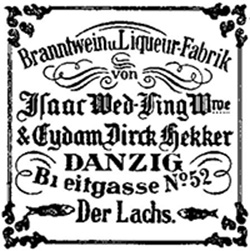 From
1598, a certain Ambrosius Vermeulen, a Mennonite who had emigrated from Flanders
[2], produced cherry liqueur in Danzig, which for some reason he called
(attention!) "krambambuli". Ambrosius had no sons, so the enterprise soon came
under the management of Isaac Wedling, who married Vermeulen's daughter (later
it changed owners more than once, passing as a dowry through the female line).
Apparently, Danzig krambambuli was in demand, since in 1704 the distillery moved
to Breitgasse 52 (now Szeroka Street), to a house with a salmon depicted on the
façade. It was this emblem that later gave the distillery its name - Der Lachs
(salmon). The bottle labels of the Der Lachs factory featured a salmon and a
six-pointed star (which was a symbol of brewers and was often depicted on the
signs of medieval taverns), as well as an inscription with the names of the
first owners of the liqueur factory: Isaac
Wed-Ling Wwe und Eydam Dirck Hekker .
From
1598, a certain Ambrosius Vermeulen, a Mennonite who had emigrated from Flanders
[2], produced cherry liqueur in Danzig, which for some reason he called
(attention!) "krambambuli". Ambrosius had no sons, so the enterprise soon came
under the management of Isaac Wedling, who married Vermeulen's daughter (later
it changed owners more than once, passing as a dowry through the female line).
Apparently, Danzig krambambuli was in demand, since in 1704 the distillery moved
to Breitgasse 52 (now Szeroka Street), to a house with a salmon depicted on the
façade. It was this emblem that later gave the distillery its name - Der Lachs
(salmon). The bottle labels of the Der Lachs factory featured a salmon and a
six-pointed star (which was a symbol of brewers and was often depicted on the
signs of medieval taverns), as well as an inscription with the names of the
first owners of the liqueur factory: Isaac
Wed-Ling Wwe und Eydam Dirck Hekker .
In addition to Krambambula, Der Lachs produced another famous strong liqueur, Goldwasser (this liqueur with the addition of 22-karat gold flakes has survived to this day and is produced in Germany by Hardenberg-Wilthen AG). The Der Lachs distillery existed until the end of World War II. And in the very same house in the old town of Gdansk where it was once located, the restaurant "Under the Salmon" has been operating for over 30 years.
It is difficult to say now how and when Krambambuli changed from a liqueur into a completely different drink. But it is absolutely certain that already more than two centuries ago German students prepared Krambambuli at their parties according to their own recipe, which, one must assume, was not distinguished by the constancy of ingredients and was a mixture of wine (or beer) and strong alcohol with the addition of spices, essentially not much different from the well-known punch. Perhaps, initially, for its preparation, students used exactly that same cherry liqueur produced by "Losos" in Danzig. But, most likely, this funny word "Krambambuli" itself perfectly suited not only the name of the drink that the students drank, but also the entire atmosphere of the student feast.

The poem "Der Krambambulist. Ein Lobgedicht über die gebrannten Wasser im Lachs zu Dantzig " (The Krambambulist. An Ode to the Fire Water of the Danzig Salmon) added to the fame of the Krambambuli, which was written in 1745 by a certain Crescentius Coromandel. This was the pseudonym of the German poet Christoph Friedrich Wedekind (1709-1777). The poem, which contained more than a hundred stanzas, formed the basis of a student drinking song. German students, drinking kneipps of their favorite drink, praised it by clinking mugs and singing a song in its honor in chorus, ending with the following lines:
Nun, Bürger von dem Weichselstrande,
Ihr Mennonisten habet Danck,
Es geh euch wohl zu Schif und Lande,
GOtt segne euren Necktartranck.
Leb, edles Dantzig, grün und blüh,
Tusch! Vivat dein Krambambuli.
(Well, Vistula-dwellers,
Mennonites, I thank you,
May you be well on land and sea,
May the divine nectar be blessed.
Noble Danzig - live and prosper!
Tush! Vivat Krambambuli!)
This song became so popular in Germany that Russian students studying at universities there brought it back to their homeland. In the twenties of the 1800s, the poet Nikolai Yazykov (1803-1846), who studied at the University of Dorpat, translated the song into Russian:
Крамбамбули, отцов наследство,
Питьё любимое у нас,
И утешительное средство,
Когда взгрустнётся нам подчас.
Тогда мы все: люли-люли!
Готовы пить Крамбамбули!
Крамбамбули, Крамбамбули!
Krambambuli, the legacy of our fathers,
Our favorite drink,
And a consoling remedy,
When we sometimes feel sad.
Then we all: lyuli-lyuli!
Ready to drink Krambambuli!
Krambambuli, Krambambuli!
And in Russia the song, as they say, “went to the people”, and soon it was sung at the table not only by students, but also by officers (while also calling the drink “zhzhenka”). Yazykov’s text was modified and supplemented. The original version of the musical accompaniment was replaced in the mid-19th century by the music of Alexander Dubuk (1812 – 1897/98).
In the 18th century, the drink was known in Poland under the name "krambambula". It was considered far from cheap and was a kind of liqueur, since it was listed in the list of alcoholic drinks known at that time along with ratafia: "... for half a quarter of a quater [3] [ratafia and krambambula] they paid one tynfa [4]."
Nowadays, krambambuli (both the drink and the song) have lost their popularity. A strong alcoholic drink based on honey (!), called "krambambulya" is produced in Belarus, positioning it as nothing more or less than "the national drink of Belarusians since the times of the Grand Duchy of Lithuania"!
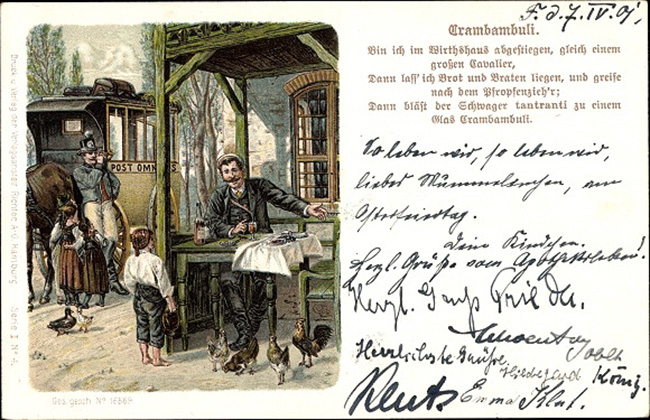
Krambambuli is drunk in large companies, so to prepare it, first of all, you will need a decent-sized wide vessel - metal, glass or ceramic. You will also need a ladle for pouring and metal tongs for sugar (there may be problems with this device, so you can replace them with something heat-resistant that can be placed on top of the vessel, for example, a pair of wide skewers or a metal grate). If you have all of the above at hand, you can proceed to the process of preparing the drink itself.
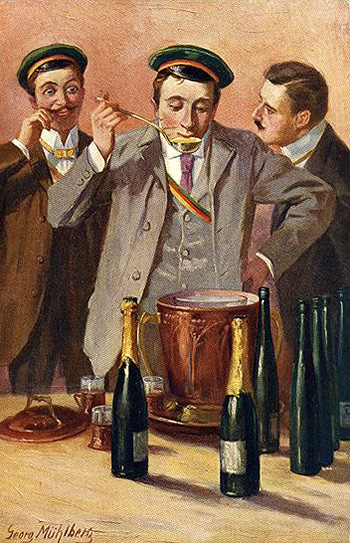
We will give several recipes for krambambuli (let us recall that at one time this was how students called any drink they consumed at a party), without claiming that the proportions and ingredients are reliable...
Red wine based krambambuli
Red dry wine - 2 bottles
Freshly squeezed orange juice - 100 ml
Lemon juice - 1 tbsp
Cinnamon - 1 stick
Granulated sugar - 8 tbsp Lump
sugar - as needed
Rum - 1 bottle
Mix wine, juice, sugar and cinnamon and heat to 70-80 degrees. Then place metal tongs with lump sugar on top of the container. Pour rum over the sugar and then set it on fire. The sugar will start to melt, and the resulting caramel will drip into the wine. Voila! Krambambuli is ready to eat.
Tea Krambambuli
Black leaf tea - a few tablespoons
Water - 1 l
Red dry wine - 1 bottle
Freshly squeezed orange juice - 200 ml
Lemon juice from one lemon
Rum - 1 bottle
Lump sugar
Boil water with tea leaves, cool slightly and add wine and juice. Then everything is as in the previous recipe.
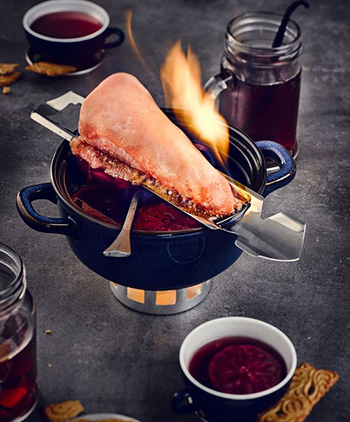
Lastly, we will give a recipe for zhzhenka, once so beloved by hussars (and not only them):
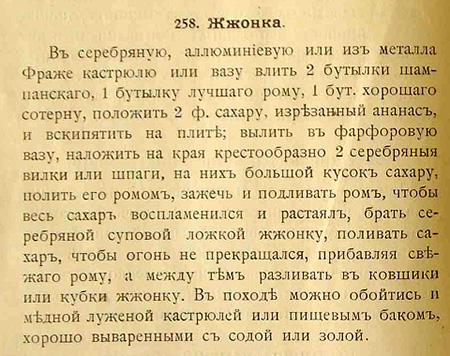
There is a restaurant in Munich called "Krambambuli". But it got its name not from the old drink, but in honor of the dog that became the main character of the story by the Austrian writer Maria von Ebner-Eschenbach (1830-1916). True, the dog got its nickname in honor of that very Danzig cherry liqueur, for 12 bottles of which the owner sold it to a passing hunter.
Those who have read this text to the end and managed to prepare krambambuli during this time can join the students of that same Dorpat (now Tartu) University and sing the Russian version of the song “Krambambuli” together with them:
Notes:
1. Rotwelsch is a late medieval jargon of thieves, beggars and vagabonds, which arose on the basis of the German language with the use of borrowings from Yiddish, Gypsy, Dutch and French. It forms the basis of modern German-language prison jargon.
2. Mennonites are members of a Protestant sect that emerged in the Netherlands in the 1530s. The founder of the sect was a former Catholic priest, Dutchman Menno Simons (1496-1561). Among other things, the sect preached pacifism, which is why the Mennonites were persecuted for a long time. Therefore, some of them emigrated from the Netherlands to West and East Prussia in the 16th century, and later even to the Russian Empire.
3. A kvaterka is a Polish unit of volume equal to 0.2356 l. Four kvaterkas make a quart, which is 0.9422 l.
4. Tynf - otherwise tymf or tynf (from tynf or tymf), a Polish small silver coin minted in the Polish-Lithuanian Commonwealth in the sixties of the 17th century.
Sources:
Raczyński Edward Obraz Polaków i Polski v 18th veka, izbiór pamiętniki, djaríuszów, publiky i listy prištnykh listy, podroų srednego izdeliyami, szczegółowych otpisov, szczegółowych szczegółowych szczegółowych, szczegółowych szczegółowych, szczegółowych szczegółowych stanja polski v 18th veka szców, — Poznan, 1841.
www.brotwein.net
www.trademarkia.com
www.arctica.lv
